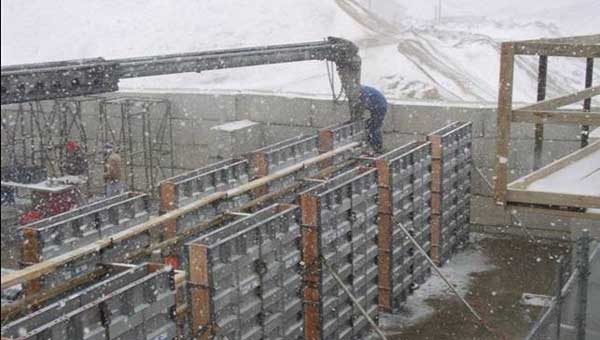Tips for Pouring Concrete Foundations in Cold Weather
As published in Concrete Contractor Magazine December 04, 2013
By James R. Baty II, F.ACI, F.TCA
Question: Concrete foundation pours in cold weather will be affected by temperatures in the mid 30s to mid 40s or lower. How should I ensure my customers and our building inspectors that the walls will perform as designed? – Concrete Contractor (Wisconsin).
Answer: There is no denying that the vast majority of basement markets in the United States are turning colder; colder to the point of concern from customers, code officials and building inspectors as to what will happen to the concrete during these placements. A wealth of information has been generated in the past decade substantiating the recommended procedures necessary to produce quality foundation concrete during these conditions. Documents such as the CFA Cold Weather Research Report, ACI 332R-06 Guide to Residential Concrete, ACI 332-10 Residential Code Requirements for Structural Concrete, and ACI 306 Guide to Cold Weather Concrete all establish consensus for the contractor to proceed with both caution and confidence under cold weather conditions.
CFA member contractors know that in order for cold weather foundation installations to be successful, there are some hard rules to recognize and follow. Most of these are related to the supporting soil condition, but some do affect the concrete and form preparation.
We asked CFA member, Dennis Purinton of Purinton Builders in East Granby, Conn., about his thoughts on cold weather concrete foundations. “The four most important things to remember in cold weather concreting are 1) mix design, 2) concrete temperature, 3) CONCRETE TEMPERATURE and 4) the correct balance of accelerator to concrete temperature.” Dennis is a CFA Board member as well as a voting member on ACI 306 (I am also a voting member on ACI 306). Dennis is also the head of a new task force CFA has formed to research cold weather performance of residential concrete slabs.
What do these mean for you? Consider the following:
1. The excavation must be not be frozen and must also be free of frost. The foundation system is designed based on the strength or rather bearing capacity of the supporting soil. Frozen ground expands and therefore changes its support condition. Once frozen ground has received a structure, that structure is falsely supported by the expanded grade and will experience settlement as the ground thaws.
2. Concrete must be protected from freezing until it has reached 500 psi. It must be protected from multiple freeze/thaw cycles until it has reached 3,500 psi. The freezing point of concrete is in the neighborhood of 27° F, depending on the concrete mix. Concrete has remarkable strength gain characteristics due to the natural hydration process. Significant research conducted on full-scale wall elements by the CFA has resulted in a more thorough understanding of this performance.
This does not mean that concrete walls will not freeze, as they will and they may below the 500 psi benchmark. Contractors must also understand the behavior of even colder ambient temperatures that may flash freeze concrete or accelerate the temperature drop so that they can plan protection such as blankets and in the most severe cases, auxiliary heat sufficient to meet the strength gain goals.
3. Mix design must be considered a top priority for successful cold weather concrete. Water-cementitious material ratio is very important for success. Water is required for the hydration process and is consumed by it. However, water is also the culprit for freezing. The higher the water content, the more susceptible the concrete is to early freezing. Cement type is another important decision, such as Type III cement with characteristics of faster strength gain. Another aspect of the decision process for cold weather concrete is the use of admixtures. Calcium chloride and non-chloride accelerators (NCAs) are proven to be very effective at accelerating the hydration process, generating greater internal heat and thereby strength gain. The final important decision is temperature at production and delivery. The higher the concrete temperature at delivery time, the more likely 500 psi will be attained in very cold conditions before freezing. The CFA Cold Weather Report offers:
Contractors should work with their local ready-mixed concrete producer to design concrete mixes that will perform well based on the expected variables for a placement. The mix designs used in this research provide a sound basis for your own mix development but should be used after localized testing.
A wealth of recommendations is available in the resources this industry has at its disposal. ACI 332-10, ACI 332R-06 and ACI 306 are all available through the bookstore at www.concrete.org. The CFA Cold Weather Report is likewise available through the online order system at www.cfaconcretepros.org. CFA also offers its members annual free webinars on cold weather concrete preparation as well as a task force that members can access for discussion and experience. In addition, an expanded version of this Q&A has been made available at CFA’s Concrete Facts.
About the author
James R. Baty II is the Executive Director for the Concrete Foundations Association and has served the association since 2001. As a member of the American Concrete Institute, he is past chair of the ACI 332 Residential Concrete Code committee and a current voting member of ACI committees 306 (chair), 332, 551 (secretary), C-650, C-655 (chair), CSAO, 332-D (chair) and 319. He is a frequent presenter on concrete topics including cold weather, thermal performance, construction best practices and the various codes influencing residential concrete foundations and the larger concrete industry in general. He can be reached for additional information at jbaty@cfaconcretepros.org or through the Association website, www.cfaconcretepros.org.








